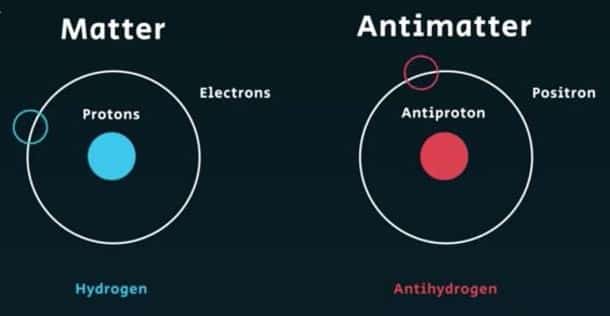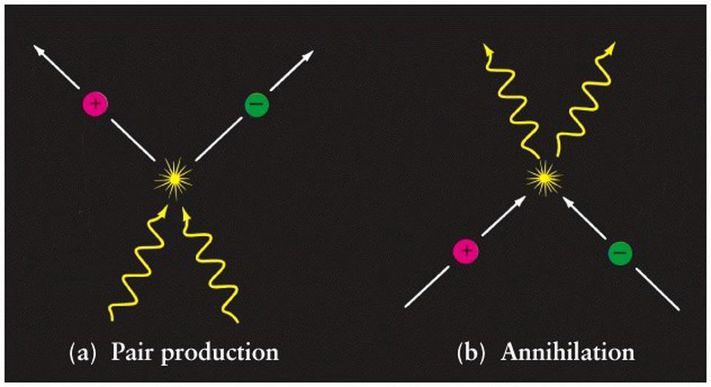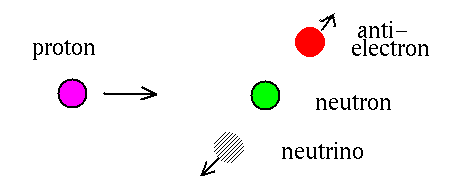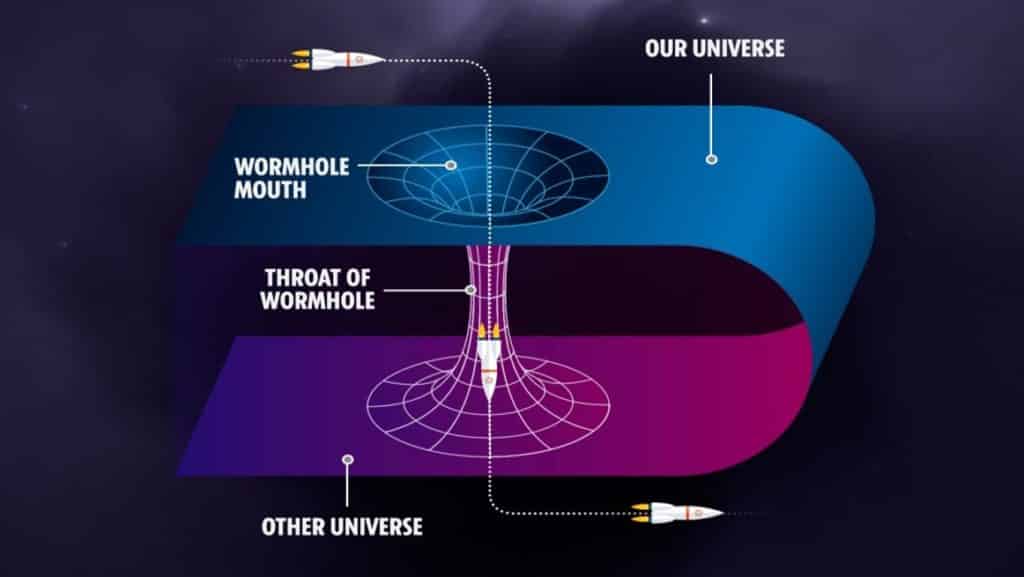Matter is anything that has mass and takes space. But apart from the ‘normal’ matter, there are different other forms of hypothesized matter. A few examples include Dark Matter, Anti Matter, and Negative Matter.
You by now know that matter and energy are interconvertible; so there is Dark Energy, Anti Energy, and Negative Energy too.
Dark Energy and Dark Matter
The term ‘dark’ is used to denote the unknown.
- Dark energy is an unknown form of energy that is hypothesized to permeate (spread throughout) all of space, tending to accelerate the expansion of the universe.
- Dark matter works like an attractive force — a kind of cosmic cement that holds our universe together. This is because dark matter does interact with gravity, but it doesn’t reflect, absorb or emit light.
- Meanwhile, dark energy is a repulsive force — a sort of anti-gravity — that drives the universe’s ever–accelerating expansion.
- Dark energy is the far more dominant force of the two, accounting for roughly 68 percent of the universe’s total mass and energy.
- Dark matter makes up 27 percent.
- And the rest – a measly 5 percent is all the regular matter we see and interact with every day.
- The velocity of rotation for spiral galaxies depends on the amount of mass contained in them, But the outer arms of the Milky Way are rotating much too fast to be consistent with the amount of matter that we know exists in them.
- Such fast rotation is possible only when there is more mass, and that extra mass is believed to come from dark matter.
- Dark matter is a hypothetical form of matter. The majority of dark matter is thought to be composed of some as-yet-undiscovered subatomic particles.
- The name dark matter refers to the fact that it does not appear to interact with observable electromagnetic radiation, such as light.
- It is thus invisible (or ‘dark’) to the entire electromagnetic spectrum, making it extremely difficult to detect.
- Dark matter interacts with the rest of the universe only through its gravity (that’s how we know it exists).
- The material is considered to be a ‘matter’ since it has gravitational attraction and it is ‘dark’ because it does not seem to interact with light (or any part of the electromagnetic spectrum).

Are Black Holes Dark Matter?
Black holes could be considered as a dark matter for the reasons mentioned below:
- Almost collision-less.
- They are stable (if sufficiently massive)
- They have non-relativistic velocities.
- They formed very early in the history of the universe.
In March 2016, 3 groups of researchers proposed that Black Holes had a primordial origin. Results from 2 groups are consistent with the scenario that almost all dark matter is made of primordial black holes. 3rd group concluded that black holes contributed to only less than 1% of total dark matter.
Anti-Matter and Anti Energy
- ‘Anti’ means the opposite. So anti-matter has some properties opposite with respect to the usual matter.
- For example, the electron has as its antiparticle the antielectron. The electron and the antielectron have exactly the same masses, but they have exactly opposite electrical charges.
- It is hypothesized that every elementary particle in the Universe has a partner particle, known as an ‘antiparticle’.
- The particle and its antiparticle share many similar characteristics, but many other properties are the exact opposite.
- The electron, for example, has as its antiparticle the antielectron. They both have the same masses, but they have exactly opposite electrical charges.
- Most of the human understanding of anti-matter comes from high-energy accelerator experiments.
- When a matter particle meets its antimatter particle, they destroy each other completely (i.e. annihilation), releasing the energy equivalent of their rest masses (following Einstein’s E = mc2).
- For instance, when an electron meets an antielectron, the two annihilate and produce a burst of light which produces a corresponding energy level equivalent to the masses of the two particles.

Negative Matter and Negative Energy
- Negative matter is a hypothetical type of matter which if it exists will have negative mass and negative energy.
- It will in essence have a negative gravitational charge and repel normal matter. Yet it will interact just like any other matter in every other way.
- Hope you remember that matter and anti-matter will attract each other resulting in annihilation. But matter and the negative matter will repel each other under gravity.

Neutrinos
- Proton, neutron, and electron are tiny particles that make up atoms. The neutrino is also a tiny elementary particle, but it is not part of the atom.
- A neutrino is a subatomic particle that is very similar to an electron but has no electrical charge and a very small mass, which might even be zero.
- There are actually three kinds of neutrinos: the electron neutrino, the muon neutrino, and the tau neutrino.
- Neutrinos are one of the most abundant particles in the universe. Because they have very little interaction with matter, however, they are incredibly difficult to detect.
- It interacts very weakly with other matter particles. So weakly that every second trillion of neutrinos fall on us and pass through our bodies unnoticed.
- Neutrinos come from the sun (solar neutrinos) and other stars, cosmic rays that come from beyond the solar system, and from the Big Bang from which our Universe originated. They can also be produced in the lab.
- The INO(India-based Neutrino Observatory) will study atmospheric neutrinos only. Solar neutrinos have much lower energy than the detector can detect.

Future Applications of Neutrino Science
Basic sciences research is needed to understand the properties of particles before they can be applied. 100 years ago, when the electron was discovered, it had no foreseeable uses. Today, a world without electronics cannot be imagined.
- Properties of the sun: The visible light is emitted from the surface of the sun and neutrinos, which travel close to the speed of light, are produced in the core of the sun. Studying these neutrinos can help us understand what goes on in the interior of the sun.
- Constituents of the Universe: Light coming from distant stars can be studied by astronomers, for example, to detect new planets. Likewise, if the properties of neutrinos are understood better, they can be used in astronomy to discover what the universe is made up of.
- Probing early Universe: Neutrinos interact very little with the matter around them, so they travel long distances uninterrupted. The extragalactic (originating outside the Milky Way galaxy) neutrinos we observe may be coming from the distant past. These undamaged messengers can give us a clue about the origin of the universe and the early stages of the infant universe, soon after the Big Bang.
- Medical Imaging: Apart from direct future uses of neutrinos, there are technological applications of the detectors that will be used to study them. For instance, X-ray machines, MRI scans, etc., all came out of research into particle detectors. Hence the INO detectors may have applications in medical imaging.
Wormhole
- A wormhole is a speculative structure linking disparate points in spacetime, and is based on a special solution of the Einstein field equations. A wormhole can be visualized as a tunnel with two ends at separate points in spacetime (i.e., different locations, different points in time, or both).
- Wormholes are consistent with the general theory of relativity, but whether wormholes actually exist remains to be seen.
- Wormholes were first theorized in 1916.
- Just like black holes were predicted by Einstein’s theory of gravity long before they were experimentally observed, the existence of wormholes, too, has been predicted. Ludwig Flamm, in 1916, first discovered that they could exist.
- He described a “white hole,” a theoretical time reversal of a black hole.
- In 1935, Einstein and physicist Nathan Rosen used the theory of general relativity to elaborate on the idea, proposing the existence of “bridges” through space-time.
- These bridges connect two different points in space-time, theoretically creating a shortcut that could reduce travel time and distance.
- The shortcuts came to be called Einstein-Rosen bridges, or wormholes.
- However, the presence of wormholes has not yet been established through observation or inference by astronomers.


Very Very nice 👌
What a knowledge, amazing